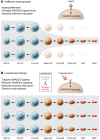Biological basis for efficacy of activin receptor ligand traps in myelodysplastic syndromes
- PMID: 31961337
- PMCID: PMC6994157
- DOI: 10.1172/JCI133678
Biological basis for efficacy of activin receptor ligand traps in myelodysplastic syndromes
Abstract
Signaling by the TGF-β superfamily is important in the regulation of hematopoiesis and is dysregulated in myelodysplastic syndromes (MDSs), contributing to ineffective hematopoiesis and clinical cytopenias. TGF-β, activins, and growth differentiation factors exert inhibitory effects on red cell formation by activating canonical SMAD2/3 pathway signaling. In this Review, we summarize evidence that overactivation of SMAD2/3 signaling pathways in MDSs causes anemia due to impaired erythroid maturation. We also describe the basis for biological activity of activin receptor ligand traps, novel fusion proteins such as luspatercept that are promising as erythroid maturation agents to alleviate anemia and related comorbidities in MDSs and other conditions characterized by impaired erythroid maturation.
Conflict of interest statement
Figures



Similar articles
-
Luspatercept in Myelodysplastic Syndromes: Who and When?Hematol Oncol Clin North Am. 2020 Apr;34(2):393-400. doi: 10.1016/j.hoc.2019.10.004. Epub 2020 Jan 21. Hematol Oncol Clin North Am. 2020. PMID: 32089218 Review.
-
Luspatercept in the treatment of lower-risk myelodysplastic syndromes.Future Oncol. 2021 Apr;17(12):1473-1481. doi: 10.2217/fon-2020-1093. Epub 2021 Jan 29. Future Oncol. 2021. PMID: 33511859 Review.
-
Activin Receptor II Ligand Traps and Their Therapeutic Potential in Myelodysplastic Syndromes with Ring Sideroblasts.Curr Hematol Malig Rep. 2016 Dec;11(6):416-424. doi: 10.1007/s11899-016-0347-9. Curr Hematol Malig Rep. 2016. PMID: 27595736 Review.
-
Modified activin receptor IIB ligand trap mitigates ineffective erythropoiesis and disease complications in murine β-thalassemia.Blood. 2014 Jun 19;123(25):3864-72. doi: 10.1182/blood-2013-06-511238. Epub 2014 May 2. Blood. 2014. PMID: 24795345 Free PMC article.
-
Splicing of erythroid transcription factor is associated with therapeutic response in myelodysplastic syndromes.J Clin Invest. 2025 May 27;135(13):e189266. doi: 10.1172/JCI189266. eCollection 2025 Jul 1. J Clin Invest. 2025. PMID: 40424086 Free PMC article.
Cited by
-
Management of Adverse Events and Supportive Therapy in Relapsed/Refractory Multiple Myeloma.Cancers (Basel). 2021 Oct 4;13(19):4978. doi: 10.3390/cancers13194978. Cancers (Basel). 2021. PMID: 34638462 Free PMC article. Review.
-
Clinical and Molecular Insights in Erythropoiesis Regulation of Signal Transduction Pathways in Myelodysplastic Syndromes and β-Thalassemia.Int J Mol Sci. 2021 Jan 15;22(2):827. doi: 10.3390/ijms22020827. Int J Mol Sci. 2021. PMID: 33467674 Free PMC article. Review.
-
Next-generation therapy for lower-risk MDS.Hematology Am Soc Hematol Educ Program. 2023 Dec 8;2023(1):59-64. doi: 10.1182/hematology.2023000520. Hematology Am Soc Hematol Educ Program. 2023. PMID: 38066862 Free PMC article.
-
Targeting inflammation in lower-risk MDS.Hematology Am Soc Hematol Educ Program. 2022 Dec 9;2022(1):382-387. doi: 10.1182/hematology.2022000350. Hematology Am Soc Hematol Educ Program. 2022. PMID: 36485128 Free PMC article.
-
The use of luspatercept for thalassemia in adults.Blood Adv. 2021 Jan 12;5(1):326-333. doi: 10.1182/bloodadvances.2020002725. Blood Adv. 2021. PMID: 33570654 Free PMC article. Clinical Trial.
References
Publication types
MeSH terms
Substances
LinkOut - more resources
Full Text Sources
Other Literature Sources
Medical

